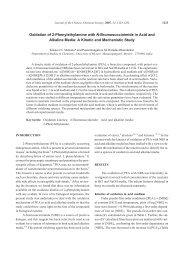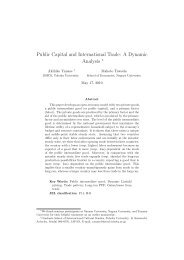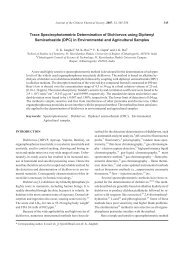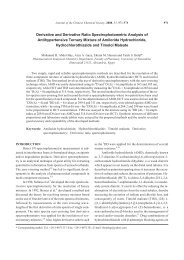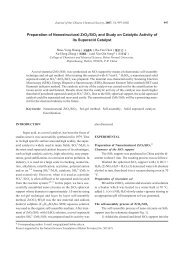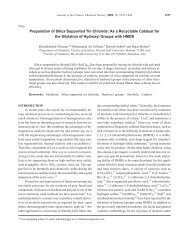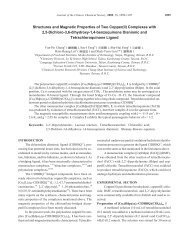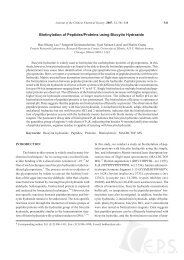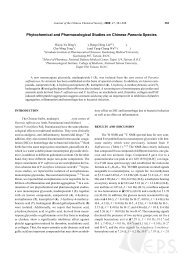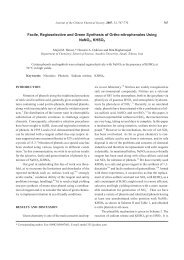Synthesis of Gold Nanosheets through Thermolysis of Mixtures of ...
Synthesis of Gold Nanosheets through Thermolysis of Mixtures of ...
Synthesis of Gold Nanosheets through Thermolysis of Mixtures of ...
You also want an ePaper? Increase the reach of your titles
YUMPU automatically turns print PDFs into web optimized ePapers that Google loves.
Fabrication <strong>of</strong> <strong>Gold</strong> <strong>Nanosheets</strong> <strong>through</strong> <strong>Thermolysis</strong> J. Chin. Chem. Soc., Vol. 56, No. 1, 2009 103<br />
8a and 8b respectively. On the other hand, ionic [C 18 -<br />
imH]Cl and [C 18 -imH][AuCl 4 ] possessed N(sp 2 )-H bonds,<br />
therefore N-H bands were expected. Indeed [C 18 -imH]Cl<br />
and [C 18 -imH][AuCl 4 ] showed strong N-H at 3417 (Fig.<br />
8c) and 3293 (Fig. 8d) cm -1 respectively. The difference<br />
in these two N-H positions is likely caused by the difference<br />
between the hydrogen bonding interactions <strong>of</strong> NH <br />
ClAuCl 3 and NH Cl; the latter has a stronger hydrogen<br />
bonding interaction. The sample prepared by mixing a 1:1<br />
molar<strong>of</strong>[C 18 -im]/[HAuCl 4 ] showed N-H at 3296 cm -1 (Fig.<br />
8e), suggesting the presence <strong>of</strong> [C 18 -imH][AuCl 4 ]. At the<br />
ratio <strong>of</strong> 4:1 a broad N-H band at 3417 cm -1 was observed,<br />
indicating the presence <strong>of</strong> [C 18 -imH]Cl. This observation<br />
can be reasoned that at 4:1 molar ratio, C 18 -im may have<br />
better chance to react with AuCl 4 - to form neutral (C 18 -<br />
im)AuCl 3 (eq. 2), therefore more [C 18 -imH]Cl may be<br />
formed.<br />
The 1 H-NMR spectra <strong>of</strong> C 18 -im (Fig. 9a), (C 18 -<br />
im)AuCl 3 (Fig. 9b), [C 18 -imH]Cl (Fig. 9c), [C 18 -imH]<br />
[AuCl 4 ] (Fig. 9d), [C 18 -im]/[HAuCl 4 ] (1:1) (Fig. 9e), and<br />
[C 18 -im]/[HAuCl 4 ] (4:1) (Fig. 9f) in d 6 -DMSO were examined.<br />
Because the chemical shifts <strong>of</strong> C 2,4,5 -H protons are<br />
sensitive to the surrounding environment, they were used<br />
to monitor the formation <strong>of</strong> each individual species. The<br />
neutral C 18 -im and (C 18 -im)AuCl 3 and the ionic [C 18 -<br />
imH]Cl and [C 18 -imH][AuCl 4 ]hadC 2,4,5 protons at 7.58,<br />
7.12, 6.85; 9.08, 7.75, 7.65; 9.21, 7.79, 7.67, and 9.11,<br />
7.75, 7.67 ppm, respectively. For the 1:1 mixture the corresponding<br />
chemical shifts were at 9.11, 7.77, and 7.68 ppm.<br />
These values were close to that <strong>of</strong> the ionic [C 18 -imH]<br />
[AuCl 4 ], consistent with the results from IR studies. For the<br />
4 to 1 mixture, the values at 8.65, 7.56, and 7.40 ppm could<br />
not be assigned to any <strong>of</strong> the species mentioned. An exchange<br />
<strong>of</strong> imidazole among C 18 -im, (C 18 -im)AuCl 3 ,[C 18 -<br />
imH][AuCl 4 ]and[C 18 -imH]Cl may however explain the<br />
results.<br />
Diffractograms <strong>of</strong> C 18 -im (Fig. 10a), (C 18 -im)AuCl 3<br />
(Fig. 10b), [C 18 -imH]Cl (Fig. 10c), [C 18 -imH][AuCl 4 ](Fig.<br />
10d), [C 18 -imH]/[AuCl 4 ] (1:1) (Fig. 10e), and [C 18 -im]/<br />
[HAuCl 4 ] (4:1) (Fig. 10f) are given and compared. Diffractogram<br />
<strong>of</strong> the 1:1 mixture (Fig. 10e) showed patterns<br />
corresponding to that <strong>of</strong> [C 18 imH][AuCl 4 ] and (C 18 -<br />
im)AuCl 3 ; the former had a much higher (001) peak intensity<br />
than that <strong>of</strong> the latter (around 3:2). Diffractogram for<br />
the sample with molar ratio <strong>of</strong> 4:1 is complicated. Although<br />
we were unable to identify the species in the 4:1 mixture<br />
from the diffractogram, the observation <strong>of</strong> reflections with<br />
corresponding d-spacings <strong>of</strong> 28.0, 14.0, and 9.3 Å suggests<br />
the formation <strong>of</strong> lamellar structure.<br />
Fig. 8. Infrared spectra <strong>of</strong> (a) C 18 -im, (b) (C 18 -<br />
im)AuCl 3 , (c) [C 18 -imH]Cl, (d) [C 18 -imH]<br />
[AuCl 4 ], (e) [C 18 -im]/[HAuCl 4 ] (1:1), and (f)<br />
[C 18 -im]/[HAuCl 4 ] (4:1). All spectra were obtained<br />
in KBr pellets.<br />
Fig. 9. The 1 H-NMR <strong>of</strong> (a) C 18 -im, (b) (C 18 im)AuCl 3 ,<br />
(c) [C 18 -imH]Cl, (d) [C 18 -imH][AuCl 4 ], (e)<br />
C 18 im/HAuCl 4 (1:1), and (f) C 18 im/HAuCl 4<br />
(4:1) in d 6 -DMSO.



